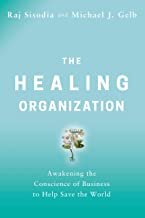The Healing Organization
Awakening the Conscience of Business to Help Save the World


Raj Sisodia is a co-founder of the Conscious Capitalism movement. He is the Whole Foods Market Research Scholar in Conscious Capitalism and FW Olin Distinguished Professor of Global Business at Babson College in Massachusetts and author/co-author of many books including the seminal Firms of Endearment and Everybody Matters. Michael J Gelb is an authority on personal and organizational development. A pioneer in the field of creative thinking, innovation literacy and conscious leadership, he helps organizations develop more creative, innovative and conscious cultures. He is the author of How to Think Like Leonardo da Vinci, amongst other titles.
Business bookstore shelves are filled with titles that glorify sociopathic empires and their leaders, perhaps the apogee of which is 'The Leadership Secrets of Attila the Hun', but also includes the analyses of 'The Art of War' by Sun Tzu and many others. TV programs such as The Apprentice and Shark Tank (Dragon's Den in the UK) do little to change this approach. Sisodia and Gelb quote these examples at the outset and set out to see how we can identify better metaphors and examples to make work less ruthless or brutal and more well-being oriented.
The authors reserve judgement on whether the likes of JP Lemann, boss of investment firm 3G, or Al Dunlap the notorious CEO featured in The Psychopath Test and others are 'bad people' preferring to quote Mohammad Yunus, the Nobel laureate, "it is not because bad people are running the machine; just that the machine is built that way. The system was not designed to have any moral responsibility. This machine turns people into money-centric robots". The core idea is that businesses operate better when they are 'ministries' (that is caring about peoples' souls as much as profit) rather than 'empires'.
Sisodia and Gelb describe three principles that lead to a Healing Organization:
They explore the details of this, but at root, it is little different from all core leadership development – the first step is becoming more self-aware, 'know thyself' – and with this awareness follow the ancient edict 'primum non nocere: first, do no harm'. The headline elements are: Eliminate harmful rules, essentially micro-management; minimise hierarchy and dont incentivise bad behaviour; never enable abuse, eradicate sociopathy, egomania and pretension; have a positive impact in all dimensions; include families as stakeholders, employees with happy families tend to be happy employees; be heroic, where heroes subsume themselves to the happiness, progress and contentment of others; evolve; be bounded by love rather than fear.
The book is primarily taken up with examples of businesses that have successfully adopted – and flourished – by adhering to Healing Organization principles. It would be easy to knock much of the advice as being too soft and new-age to actually work, but the authors are aware that profit remains the oxygen of businesses stating 'it is irresponsible for a business not to be profitable', and as such has to be sought. But this profit has to be balanced, and their examples show, can significantly enhance, the acquisition of profit, if businesses follow a practice of caring for their employees in a firm, fair and nurturing manner.
Title: The Healing Organization: Awakening the Conscience of Business to Heal Save the World
Author/s Name/s: Raj Sisodia and Michael J Gelb
Publisher: Harper Collins Leadership
ISBN: 978-0-814-43981-4
Publishing Date: September, 2019
Number of Pages: 288
Author Knowledge Rating: 1-5 (based on their years of experience, academic expertise in subject areas, and exposure to cross-functional thinking in the area)



























































Readability: 1-5 score(1=dense and v academic; 5=frantic; page turner)












































































Appropriate Length: (1=could have been written in 25% of the length;5=could have been longer)












































































Core Idea Value: (1=nonsense (or entirely esoteric); 5=game-changer)

























































































